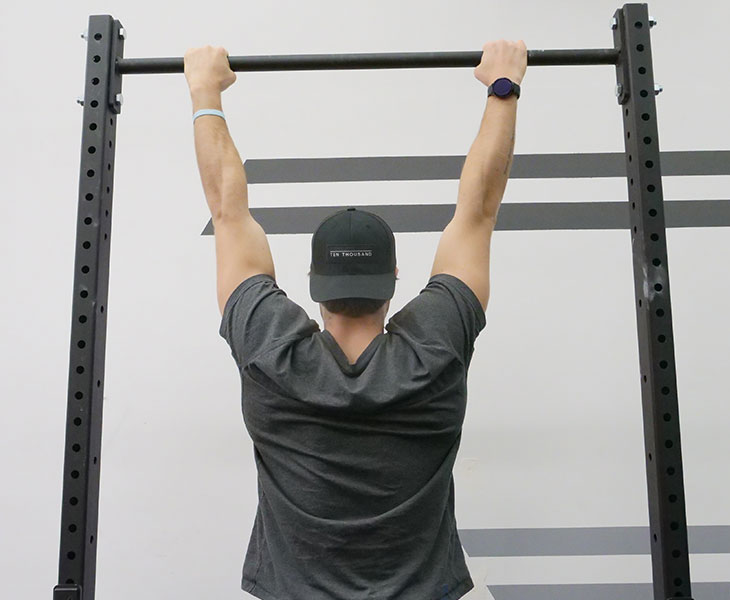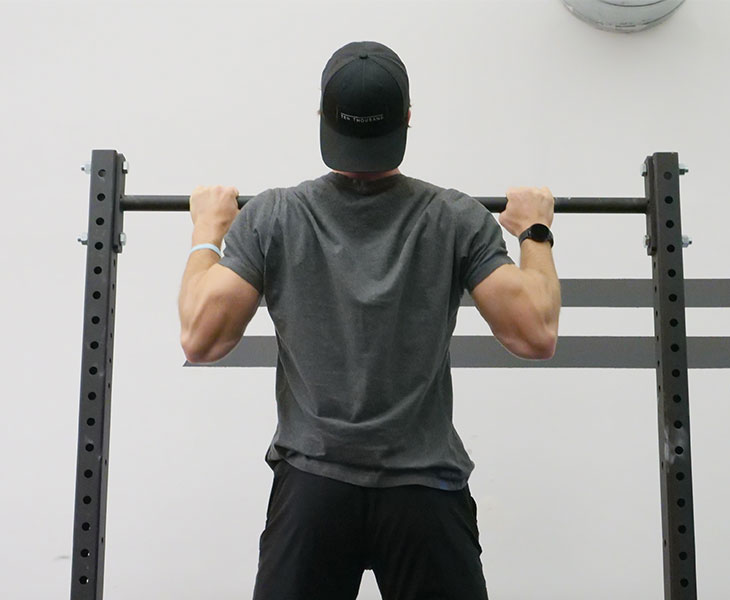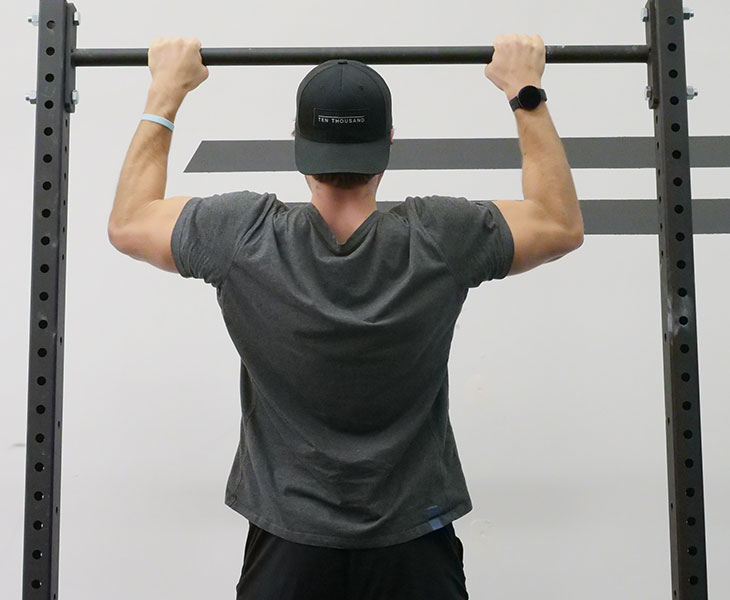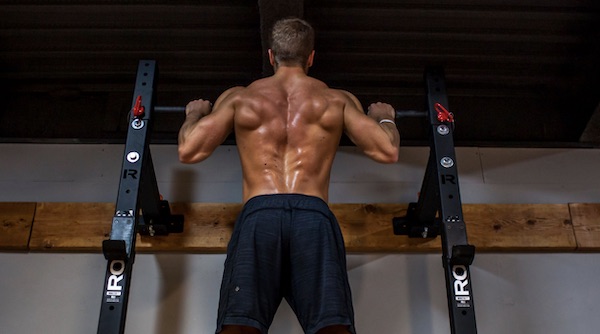The pull-up could be referred to as a milestone exercise. The ability to successfully lift one’s chin over a pull-up bar from a dead hang position is incredibly self-empowering.
For true beginners, the pull-up can sometimes be a feat of strength that seems almost incomprehensible. After all, it’s an exercise that requires ample upper body strength, coordination, and form to have success with, so it needs to be practiced like any other skill.
The best way to think about conquering a first pull-up is to pursue it like any other desirable skill. You need to spend time to build a base, practice the trade often, and have a plan in place to thoughtfully nail your first rep. For this article, we’re going to cover some pull-up basics/FAQs and then provide a 4-week beginner pull-up program.
If you’re more of a visual learner, then check out the video below diving into the 4-week pull-up program!
Pull-Up Basics
The best way to think about a pull-up for beginners — in my opinion — is to separate it from how we think about traditional exercises. Instead of simply thinking that the pull-up is another move that has to be done in the gym, think about it as a skill and a major milestone for upper body strength.
If we can shift our perception towards how we think about pull-ups, then we can attack them with strategy and precision. There’s a lot more that goes into a great pull-up than simply jumping up to the bar and pulling the body upwards.
What’s the difference between a pull-up and chin-up?
The main difference between a pull-up and a chin-up is hand position. The pull-up will have the palms facing away from the body, and in the chin-up, the palms will be facing the chin.
An easy way to remember the hand differences that come along with chin-ups and pull-ups is to think about how you’d scratch your chin. You would scratch your chin with the palm facing your body — that’s a chin-up!
What muscles does the pull-up work?
The pull-up is a multi-joint exercise that works multiple upper body muscles. The lats serve as the prime mover for the pull-up and there are multiple supporting muscles that are active through various ranges of motion during this exercise. Check out some of the below the pull-up works below.
- Latissimus Dorsi — Prime Mover
- Biceps Brachii
- Infraspinatus
- Lower Trapezius
- Pectoralis Major
- Erector Spinae
- External Oblique
What are the benefits of pull-ups?
There are a ton of benefits that come with pull-ups, and that’s why it’s so essential for everyone to learn them. The pull-up is a great milestone for upper body strength and can be a serious confidence booster to keep you on track.
1. Upper Body Strength Milestone
For the true beginner, the pull-up can serve as an awesome long-term training goal, which can help newer fitness enthusiasts stay on track with their progress and motivated. Upper body strength progress with the pull-up can be tracked by reps, technique, and overall movement efficiency.
2. Multiple Muscles Targeted
Few things compare to the impressiveness of a well-defined, strong back. The pull-up is arguably one of the best exercises for training the back muscles and building a strong upper body.
3. Grip Strength Enhancer
Lacking grip strength? The pull-up has you covered. The pull-up is fantastic for improving grip strength, especially when you add in tempos, reps, and holds.
How often can you train pull-ups?
Pull-ups are an exercise that can be trained as often as you have the energy for them.
Ideally, you want to train pull-ups with a frequency that coincides with your main training goal, energy availability, and fitness level.
This is why it’s important to follow a well-written workout program that either has pull-ups included and accounted for within, or a program that is designed specifically for or around pull-ups. Basically, you can train pull-ups as often you’d like as long as there’s strategy behind them.
How-To Do Pull-Ups
In order to nail perfect pull-ups, one must understand the basics that come along with the movement. Check out the full pull-up how-to below!

1.
Establish Your Grip
Start by assuming a pronated grip on a bar with your hands slightly wider than shoulder-width apart.
Be sure to freely hang at the bottom of the pull-up. You should be able to have your head in between your biceps with the elbows fully extended. Additionally, set your shoulder blades down the back by retracting and depressing them, as this will help secure the shoulder girdle from moving around during the pull-up.

2.
Set the Back, Then Pull
Once you’ve set your grip, retract the scapula slightly to create a firm foundation to begin your pull-up from. This retraction will be very subtle and will “open” the chest slightly when done correctly.

3.
Drive the Elbows to the Floor
Once set, pull the chest and chin to the barbell by way of the back and bicep muscles.
Think about pulling the bar to your chest so that the elbows drive into your back pockets. You can also think about driving the elbows through the floor as you pull yourself upwards.

4.
Stabilize and Descend
Once you have arrived at the top of the bar, stabilize your body and then lower yourself to the start position under control.
Be sure to keep tension on the back and in between the shoulder blades throughout this moment, and always secure a stable core and shoulder girdle prior to proceeding into another repetition.
4-Week Beginner Pull-Up Program
In this beginner pull-up program, there are 4-weeks that progressively load and get harder to help you achieve your first pull-up. The workouts throughout the four weeks below can be used as supplementary work for what you already do, or as a stand alone program.
The goal was to provide the option for following this program by itself, or adding it into a current routine. If you want to fully focus on achieving your first pull-up, then make the workouts below the main focal point on training days, and if you want to keep doing what you’re doing with this program, then add the workouts in where they fit best.
Use your energy availability and best judgement when adding the weekly workouts below to a current routine. My advice, perform these workouts before your normal training days, and potentially drop the volume slightly for your regular workout to avoid overreaching. Take a day or two of rest in-between the workout days below as well.
Beginner Pull-Up Program Key Stats
- Frequency: 2-3x/Week
- Total Workout Time: 15-20 minutes (this can vary if you want to take longer rests)
- Total Exercises to Be Performed In Program: 5
- Program Goals: Achieve first pull-up
Rest Times and Scaling Intensity
If a week becomes too difficult, or you find yourself missing reps, then repeat that week and elongate the program’s timeline accordingly. There is no need to push for a fictitious timeline with this program.
With rest times, rest as long as you need to feel fully ready for following sets. There’s no need to rush through the program and miss reps due to lack of rest.
Exercises In the Program
This program was designed to be effective and simple. For this reason, there will only be five different exercises performed throughout the four weeks and they’ll rotate accordingly. Every week, the sets, reps, and intensities will vary slightly to keep you progressing.
- Dumbbell Row
- Inverted Row
- Pull-Up Holds/Pauses
- Eccentric Pull-Ups
- Band-Assisted Pull-Ups
Week 1: 2 Training Days

Performance Notes
- Dumbbell Row: Perform every set leaving 1-2 reps left in the tank.
- Inverted Row: Set between pec height and belly button
Week 2: 3 Training Days

Performance Notes
- Dumbbell Row: Perform every set leaving 1-2 reps left in the tank.
- Inverted Row: Set between pec belly button and knee height.
- Band Assisted Pull-Up: Use machine/band and complete 10 somewhat challenging reps.
Week 3: 3 Training Days

Performance Notes
- Dumbbell Row: Perform every set leaving 1-2 reps left in the tank.
- Inverted Row: Set around knee height.
Week 4: Day 1

Performance Notes
- Inverted Row: Set around knee height.
Week 4: Day 2

Performance Notes
- Inverted Row: Set around knee height.
- Assisted Pull-Up: Keep light!
Week 4: Day 3
Attempt your first pull up!
If you follow the program and find success, please share your results and progress below!
